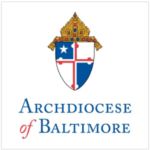LIBERTYTOWN, MD — August 25, 2008 — On the morning of August 25th a giant crane gently restored the historic steeple of St. Peter the Apostle Roman Catholic Church on the top of a brand new church building. A Libertytown landmark since 1871, St. Peter’s steeple was engulfed in flames on June 3, 2004 when renovation work accidentally overheated and fire spread to the tarp-covered roof, destroying the picturesque county church. Four years later, the new, substantially larger St. Peter’s will be officially dedicated on Sunday, September 7th at 3:00 p.m. by Archbishop Edwin F. O’Brien, Archbishop of Baltimore. Archbishop O’Brien, along with St. Peter’s pastor, Monsignor John Dietzehbach, and 40 priests and deacons from the area, will lead a procession of parishioners and invited guests into the new church prior to the Mass of Dedication.
Although parishioners were deeply saddened in 2004 by the loss of their beautiful church, they had been exploring the possibility of building a larger one to accommodate the parish’s 1,800 registered families. A multipurpose building, Sullivan Hall, was constructed in 1991 for additional worship space and social functions; it became the primary worship space after the fire. When rising land costs threatened to derail future construction plans, the parish’s permanent deacon, Rev. Mike Misulia – a retired surveyor – discovered that a larger church could actually fit on the original site if it were set on a diagonal plane. Following a successful capital campaign, the groundbreaking took place on April 21, 2006 at which time Cardinal Keeler announced that then-Father Dietzenbach would be elevated to the rank of Monsignor.
Now the pastor is preparing his congregation to begin worshipping in a church that seats 770 and includes numerous ties to the past. In addition to the restored steeple, the new St. Peter’s features a second, shorter steeple with a design that echoes that of the original stone church built in 1821. The new cornerstone honors parish history with images of the two previous churches along with their dedication dates. The statue of St. Peter that used to mark the location of the original stone church (in the parish cemetery) now stands proudly in the front, between the two steeples on a spacious stone patio.
The façade of the burned church was preserved and now houses a daily mass chapel while the rest of the new design highlights the brick exterior, arched windows, and dark red carpeting of the old. Even the blue interior ceiling deliberately resembles that of the historic church. Some original items were also preserved including the Stations of the Cross and a large oil painting of the Crucifixion that previously hung behind the altar. Although damaged by smoke, the painting has been beautifully restored by St. Peter’s parishioner Nancy Pollack (a professional artist) and now adorns the daily mass chapel.
Many new touches complement the old including a Eucharistic adoration chapel (located directly behind the altar), a choir loft (for potential extra seating), and a large gathering space (narthex). Looking to the future, a huge, mostly unfinished basement stands ready for additional classroom space when funds become available and local water restrictions allow. In addition to donations and fund-raising, St. Peter’s hopes to earn additional income from rentals of Sullivan Hall, a popular location for wedding receptions and social events before the 2004 fire (https://stpetersrentals.com).
St. Peter’s will be hosting receptions for the general public on the weekend after the dedication, September 13 and 14, following all masses. After Labor Day, the church’s new Weekend Mass Schedule will be as follows: Saturday: 5:30 p.m.; Sunday: 7:15 a.m., 9:00 a.m., and 11:00 a.m. Trained volunteers will also be available to provide tours to the public.

